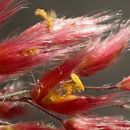Comments
provided by eFloras
This is a polymorphic, pantropical weed, recognizable by its pink, fluffy panicles.
- license
- cc-by-nc-sa-3.0
- copyright
- Missouri Botanical Garden, 4344 Shaw Boulevard, St. Louis, MO, 63110 USA
Description
provided by eFloras
Annual or loosely tufted short-lived perennial. Culms geniculately ascending, often rooting at lower nodes, up to 150 cm tall. Leaf sheaths loose, usually with tubercle-based hairs; leaf blades linear, up to 20 × 0.2–1.4 cm. Panicle silvery-pink or purple, ovate to oblong, 8–20 cm, fluffy; branches capillary; pedicels with a few long hairs. Spikelets ovate, 2–4.5 mm, densely villous, hairs up to 6 mm; lower glume narrowly oblong, 0.3–1.5 mm, 1-veined, with stiff short hairs, separated from the upper by a short internode; upper glume 5-veined, gibbous below middle, tapering upward into a glabrous membranous beak 1/4–1/2 its length, emarginate, mucronate or with short awn up to 1 mm; lower floret staminate, lemma similar to upper glume but narrower and less gibbous, palea keels ciliate; upper floret whitish, thinly cartilaginous, smooth, shining, ca. 2 mm. Fl. and fr. Jun–Nov. 2n = 36.
- license
- cc-by-nc-sa-3.0
- copyright
- Missouri Botanical Garden, 4344 Shaw Boulevard, St. Louis, MO, 63110 USA
Habitat & Distribution
provided by eFloras
Grasslands, open or disturbed places, naturalized. Fujian, Guangdong, Taiwan [native to Africa].
- license
- cc-by-nc-sa-3.0
- copyright
- Missouri Botanical Garden, 4344 Shaw Boulevard, St. Louis, MO, 63110 USA
Synonym
provided by eFloras
Saccharum repens Willdenow, Sp. Pl., ed. 4, 1: 322. 1797; Rhynchelytrum repens (Willdenow) C. E. Hubbard; R. roseum (Nees) Stapf & C. E. Hubbard; Tricholaena rosea Nees.
- license
- cc-by-nc-sa-3.0
- copyright
- Missouri Botanical Garden, 4344 Shaw Boulevard, St. Louis, MO, 63110 USA
Physical Description
provided by USDA PLANTS text
Annuals, Terrestrial, not aquatic, Stems trailing, spreading or prostrate, Stems nodes swollen or brittle, Stems geniculate, decumbent, or lax, sometimes rooting at nodes, Stems mat or turf forming, Stems terete, round in cross section, or polygonal, Stems branching above base or distally at nodes, Stem nodes bearded or hairy, Stem internodes solid or spongy, Stem internodes hollow, Stems with inflorescence less than 1 m tall, Stems with inflorescence 1-2 m tall, Stems, culms, or scapes exceeding basal leaves, Leaves mostly cauline, Leaves conspicuously 2-ranked, distichous, Leaves sheathing at base, Leaf sheath mostly open, or loose, Leaf sheath smooth, glabrous, Leaf sheath hairy, hispid or prickly, Leaf sheath and blade differentiated, Leaf blades linear, Leaf blades 2-10 mm wide, Leaf blades mostly flat, Leaf blade margins folded, involute, or conduplicate, Leaf blades mostly glabrous, Leaf blades more or less hairy, Leaf blades scabrous, roughened, or wrin kled, Ligule present, Ligule a fringed, ciliate, or lobed membrane, Ligule a fringe of hairs, Inflorescence terminal, Inflorescence an open panicle, openly paniculate, branches spreading, Inflorescence solitary, with 1 spike, fascicle, glomerule, head, or cluster per stem or culm, Inflorescence a panicle with narrowly racemose or spicate branches, Inflorescence branches more than 10 to numerous, Flowers bisexual, Spikelets pedicellate, Spikelets laterally compressed, Spikelet less than 3 mm wide, Spikelets with 1 fertile floret, Spikelets with 2 florets, Spikelets solitary at rachis nodes, Spikelets all alike and fertille, Spikelets bisexual, Spikelets disarticulating below the glumes, Spikelets conspicuously hairy , Rachilla or pedicel glabrous, Glumes present, empty bracts, Glumes 1 clearly present, the other greatly reduced or absent, Glumes 2 clearly present, Glumes distinctly unequal, Glumes equal to or longer than adjacent lemma, Glume equal to or longer than spikelet, Glumes awned, awn 1-5 mm or longer, Glume surface hairy, villous or pilose, Glumes 4-7 nerved, Lemma 1 nerved, Lemma 3 nerved, Lemma glabrous, Lemma apex dentate, 2-fid, Lemma awnless, Lemma margins thin, lying flat, Lemma straight, Palea present, well developed, Palea about equal to lemma, Palea 2 nerved or 2 keeled, Stamens 3, Styles 2-fid, deeply 2-branched, Stigmas 2, Fruit - caryopsis.

